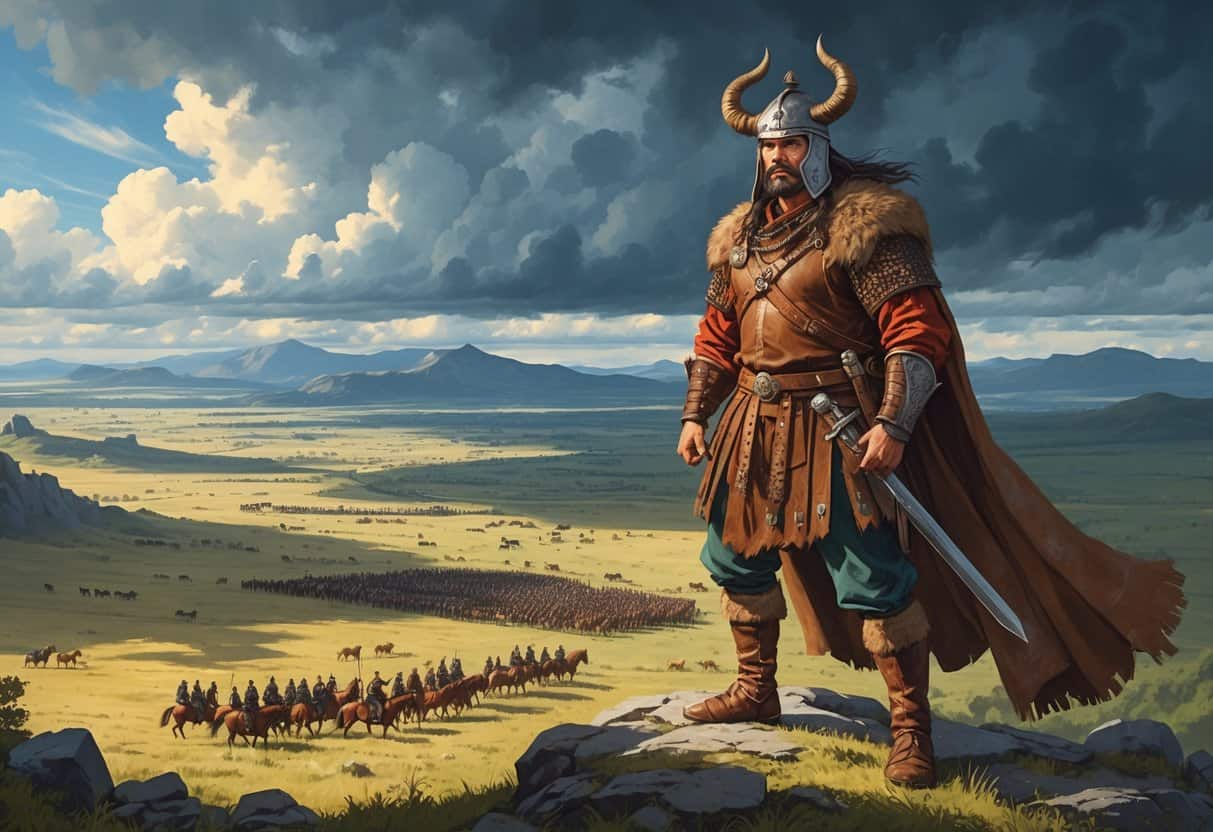Attila the Hun was a powerful leader who ruled the Hunnic Empire during the 5th century CE. He’s remembered for leading the Huns from 434 to 453 CE, pushing them to their peak and playing a part in the unraveling of the Roman Empire.
His leadership made him a terrifying figure across Europe. The moves he made really shaped a chunk of ancient history.

You’ll get a sense of who Attila was, how he rose to power with his brother Bleda, and what happened when he ruled alone after 445 CE. The fear he inspired earned him nicknames like the “Scourge of God.”
Understanding Attila lets you peek into a wild time when the old world was falling apart.
Key Takeaways
- Attila led the Huns during a key period of ancient history.
- His rule marked the peak of the Hunnic Empire’s power.
- His legacy shaped the course of European history.
The Rise of Attila the Hun

Attila emerged as a tough leader who shaped the Hunnic Empire and took on Rome. His early life and background set the stage for the empire’s fast rise and influence.
Early Life and Background
Attila was born around the late 4th century, probably somewhere in Scythia. The Huns, often called barbarians by the Romans, were actually a powerful nomadic group from Central Asia.
He grew up among tribes famous for their riding and fighting. Before Attila took over alone, he shared leadership with his brother Bleda after their uncle died.
He became the sole ruler around 434 AD, maybe by force, maybe after Bleda’s death—it’s not totally clear. Growing up in a warrior culture, Attila learned to lead with strength and a bit of fearlessness.
Hunnic Empire Expansion
Once Attila took charge, the Hunnic Empire went on a spree of conquest. From 434 to 453 AD, he pushed Hunnic control across big swaths of Eastern and Western Europe.
The empire stretched from the steppes in what’s now Hungary all the way to parts of the Roman Empire. Attila’s power came from skilled cavalry warfare and clever alliances.
He’d threaten or demand tribute from Roman territories. These attacks forced Rome into constant defense, making the Huns a real military and political headache.
| Key Points | Details |
|---|---|
| Birthplace | Scythia region, linked to Scythians |
| Shared early leadership | With brother Bleda |
| Single leadership starts | Around 434 AD |
| Empire reach | From Central Europe to Roman borders |
| Military strength | Skilled cavalry and strategic attacks |
Reign and Campaigns
Attila ruled the Huns from 434 to 453 AD. During his reign, he launched a string of military campaigns against all sorts of enemies.
His attacks put heavy pressure on the Roman Empire and neighboring tribes like the Goths and Vandals. There was also a tangled relationship with the Roman general Aetius.
Major Conflicts with the Roman Empire
Attila hit both the Eastern and Western Roman Empires with several attacks. He’d demand gold to keep the peace, but when the Romans balked, he’d invade their lands in the Balkans and Gaul.
These campaigns left Roman cities and villages in ruins. Rome’s military and economy took a beating, speeding up its decline.
Battles Against the Goths and Vandals
Attila also fought the Goths, Vandals, and other tribes controlling parts of Eastern Europe. These clashes were usually over land and influence.
His victories helped the Huns expand even more. Warfare like this uprooted local populations—many were captured, sold as slaves, or forced into Hunnic armies.
Relationship With Aetius
You can’t really get Attila’s story without mentioning Aetius, Rome’s top general at the time. They faced off in battle and in negotiations.
The big showdown was at the Battle of Chalons in 451 AD. Aetius managed to halt Attila’s push into Western Europe, but never truly defeated him.
Their rivalry shaped much of Rome’s military strategy during Attila’s reign.
Legacy and Historical Impact
Attila the Hun left a mark as both a feared warrior and a symbol of so-called barbarian power. His impact changed how people saw invasions and the rulers who followed.
The Scourge of God
Attila got called the Scourge of God—some thought he was a punishment sent by divine forces. His attacks on the Roman Empire were brutal and sudden, and the fear was real.
This title stuck because his invasions shook up the Roman world, shifting the balance of power in Europe. If you squint, you might even compare his raids to the Mongol invasion centuries later.
Attila’s name became shorthand for destruction and war, like the Four Horsemen in apocalyptic tales. It’s wild how his legend grew into something almost mythic.
Influence on Ancient and Modern Perception
Your view of Attila today is shaped by a wild mix of history and centuries-old stories. In Russian history, for instance, Attila sometimes gets blended with other famous nomadic leaders—he sort of becomes a symbol of fierce outsiders.
Modern sources like National Geographic try to strip away the myths. They focus more on facts, painting Attila as a complex leader who could rule skillfully and fight when he had to.
People used to see him as just a villain, but now he’s part of a bigger story. There’s more to his legacy than just violence—he played a role in diplomacy and the building of tribal empires that changed Europe.
